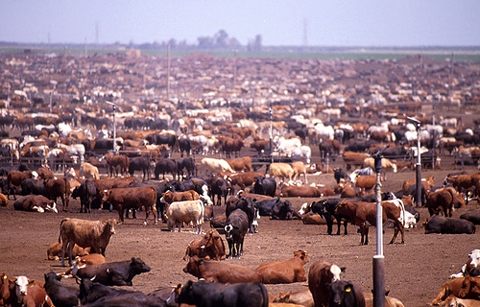 I recently told my mother in law that I had given up red meat. “For dietary reasons, or humanitarian ones?” she asked. “Neither,” I responded, “For the environment.” She gave me a puzzled look. In my mind, there was no doubt: for the health of the planet, I must do my part to reduce the demand for beef. Depending on which source you consult, there are somewhere between 0.9 billion and 1.5 billion cows in the world. Cows are vegetarian, and, as vegetarians and those who love them know, being vegetarian makes you gassy. But beyond the antisocial nature of cow farts (and burps) lurks something much more evil. Its name is methane, and its symbol is CH4. In addition to being smelly, methane also traps radiation very efficiently. Compared to CO2, pound for pound methane’s impact on climate change is 25 times greater than the same amount of CO2. According to the EPA, globally the agriculture sector is the primary source of CH4 emissions. And it’s not just cows. Sheep, goats, buffalo, and – you guessed it -- camels -- produce large amounts of CH4 as part of their normal digestive process. One article explains that a single cow can produce 66 to 132 gallons of methane a day. Compare this to the average US vehicle gas tank, which holds 16 gallons of gas. A gallon of fuel in a car produces about 1200 gallons of CO2 at standard temperature and pressure. So a cow producing 100 gallons of methane (at 25x more harmful than CO2 to the atmosphere) a day is like using about 2.5 gallons of gas per day. If the average car gets 30 mpg, the emissions from one cow are as harmful as a car driving 75 miles a day. A billion cows is like a billion extra cars each driving 75 miles a day. It’s no big surprise, then, that a report by the U.N. Food and Agriculture Organization found that the livestock sector “generates more greenhouse gas emissions as measured in CO2 equivalent – 18 percent – than transport.” To be clear: raising cattle hurts the atmosphere more than driving cars. The report also calls the livestock sector “a major source of land and water degradation.” Turns out livestock use 30 percent of the earth’s entire land surface. And supporting all those cows is a major driver of deforestation. In Latin America, 70 percent of Amazon forests have been turned over to grazing. Americans consume more than 37 million tons of meat each year. According to the National Chicken Council (are they competitors?) we Americans eat 54 pounds of beef per year, per person. That's the average. Obviously some folks are on the way high end of that scale, such as those who take on the 72-oz steak challenge offered in my home state of Texas. That also puts the USA at #5 in per capita beef consumption, behind Hong Kong, Argentina, Uruguay and Brazil. China’s per capita average is just 7 pounds per year. What about other types of meat? Beef beats them, hooves down, when it comes to environmental harm. Research suggests that beef does ten times more eco-damage than other kinds of meat. So, what can you do? If possible, give up beef and dairy products altogether. If you can’t do that, at least cut back. Meatless Mondays is a good start. Beef-free BBQs. Fro-yo-No-No Fridays. Steakless Saturdays, etc. Me? I’m committing to living a life free of cattle products from now on. (Ack! I guess that includes leather.) Thanks to lactose intolerance, I’m off to a good start. |
|
 RSS Feed
RSS Feed
